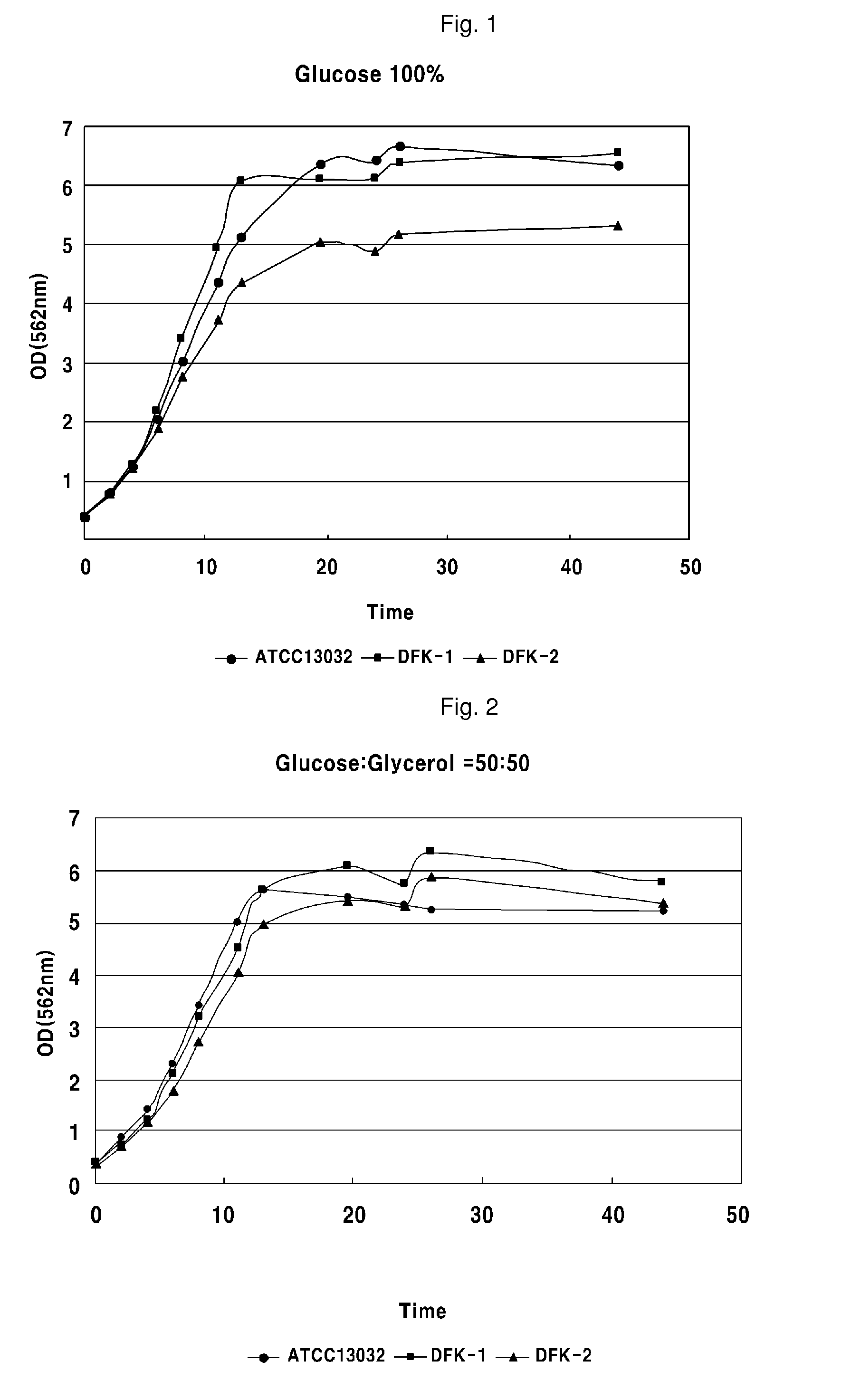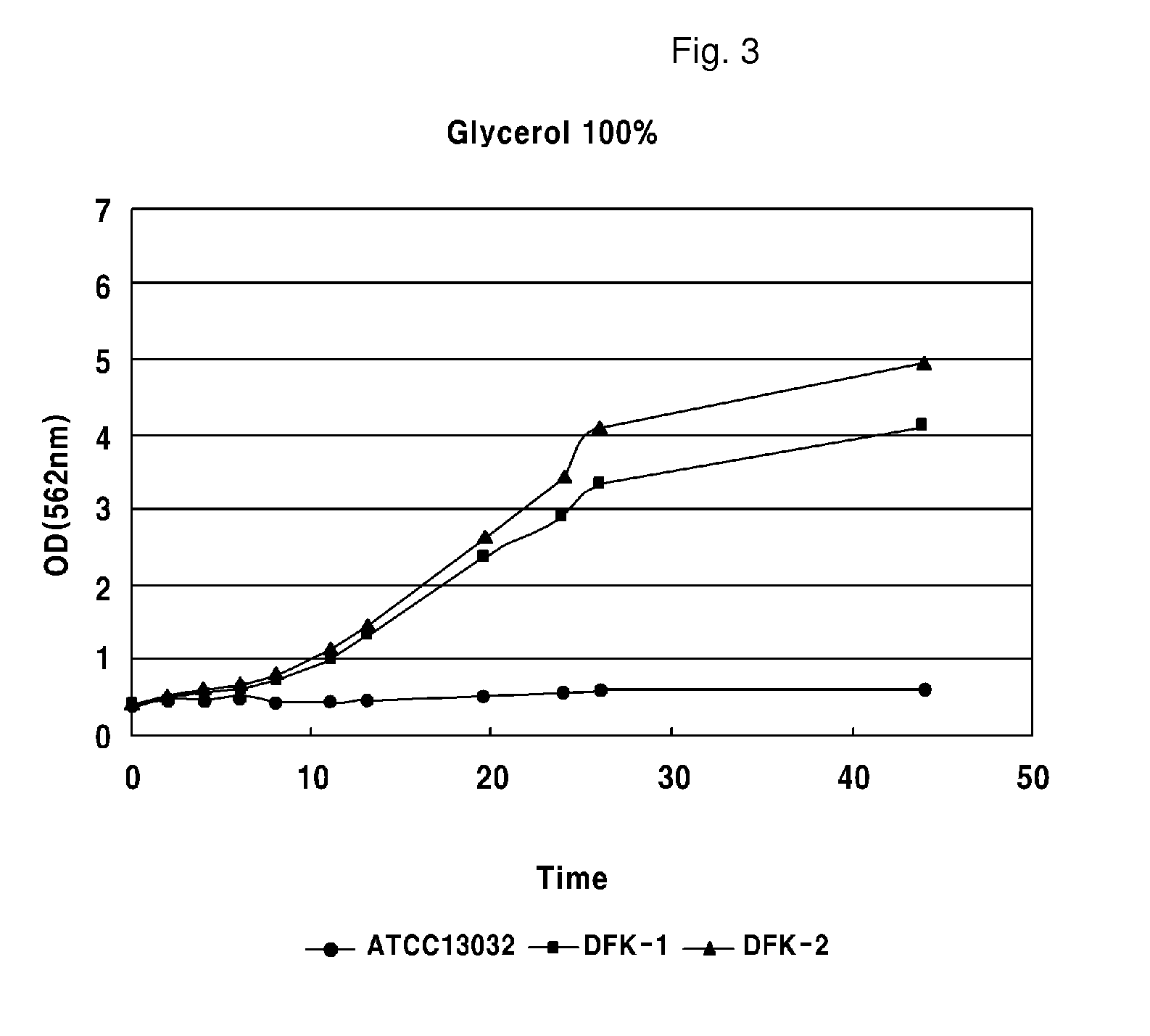Process for producing fermentation product from carbon sources containing glycerol using Corynebacteria
a technology of corynebacteria and glycerol, which is applied in the direction of enzymology, microorganisms, transferases, etc., can solve the problems of not being able to effectively treat byproducts including glycerol according to the increase of biodiesel production, and the price is reduced quickly, so as to achieve effective use, reduce fermentation efficiency, and use glycerol
- Summary
- Abstract
- Description
- Claims
- Application Information
AI Technical Summary
Benefits of technology
Problems solved by technology
Method used
Image
Examples
example 1
Screening and Cloning of a Gene Involved in the Use of Glycerol which is Operable in Corynebacteria
[0042]The nucleotide sequence of the gene involved in the use of glycerol of Corynebacterium diphtheriae has already been identified and officially released. Information about genes encoding GlpF, GlpK and GlpD (glpF, glpK and glpD respectively) which are proteins of Corynebacterium diphtheriae associated with the use of glycerol and adjacent nucleotide sequences was obtained from GeneBank, NIH, USA. Gene Bank Accession No. of GlpF of Corynebacterium diphtheriae was NC—940539.1, Gene Bank Accession No. of GlpK was NC—940538.1, and the Gene Bank Accession No. of GlpD was NC—940540.1. The genes were confirmed to be arranged in a series on a genome. So, one time PCR could amplify all of the three genes as a single polynucleotide. Primers represented by SEQ. ID. NO: 1 and NO: 2 were used for PCR to amplify the genes involved in the use of glycerol of Corynebacterium diphtheriae.
[0043]
SEQ. ...
example 2
Determination of Nucleotide Sequence and Restoration of Amino Acids Mutation of the glpDFK Gene
[0045]The plasmid obtained above was digested with Not I to obtain a DNA fragment containing the gene involved in the use of glycerol. The DNA fragment was cloned into pECCG117, E. coli-Corynebacterium shuttle vector, followed by transformation of E. coli TOP10. The transformed strain was name “E. coli CO02-0014” which was deposited at KCCM (Korean Culture Center of Microorganisms) of KFCC (Korean Federation of Culture Collection), the International Depository Authority located at 361-221, Hongje-1-Dong, Seodaemungu-Gu, Seoul, Korea, on Jan. 8, 2007 (Accession No: KCCM 10834P).
[0046]The plasmid obtained by the conventional plasmid miniprep was named pECCG117-cdi glpDFK-1. DNA nucleotide sequence of the pECCG117-cdi glpDFK-1 was determined and accordingly it was confirmed that the nucleotide sequence from 171st to 1904th encoded glpD gene (SEQ. ID. NO: 4), the nucleotide sequence from 1904t...
example 3
Introduction into Corynebacterium glutamicum ATCC13032
[0050]The prepared pECCG117-cdi glpDFK-1 and pECCG117-cdi glpDFK-2 were introduced into Corynebacterium glutamicum ATCC13032, respectively by electric pulse method. The cells were cultured on the plate medium containing bacto-peptone 10 g / L, yeast extract 10 g / L, beef extract 5 g / L, NaCl 2.5 g / L and kanamycin 25 μg / mL. The obtained colonies proceeded to PCR cloning to select the colonies containing the plasmid comprising the gene involved in the use of glycerol. The selected strains were named respectively Corynebacterium glutamicum ATCC13032 / pECCG117-cdi glpDFK-1, and Corynebacterium glutamicum ATCC13032 / pECCG117-cdi glpDFK-2.
PUM
| Property | Measurement | Unit |
|---|---|---|
| temperature | aaaaa | aaaaa |
| temperature | aaaaa | aaaaa |
| pH | aaaaa | aaaaa |
Abstract
Description
Claims
Application Information
 Login to View More
Login to View More - R&D
- Intellectual Property
- Life Sciences
- Materials
- Tech Scout
- Unparalleled Data Quality
- Higher Quality Content
- 60% Fewer Hallucinations
Browse by: Latest US Patents, China's latest patents, Technical Efficacy Thesaurus, Application Domain, Technology Topic, Popular Technical Reports.
© 2025 PatSnap. All rights reserved.Legal|Privacy policy|Modern Slavery Act Transparency Statement|Sitemap|About US| Contact US: help@patsnap.com


